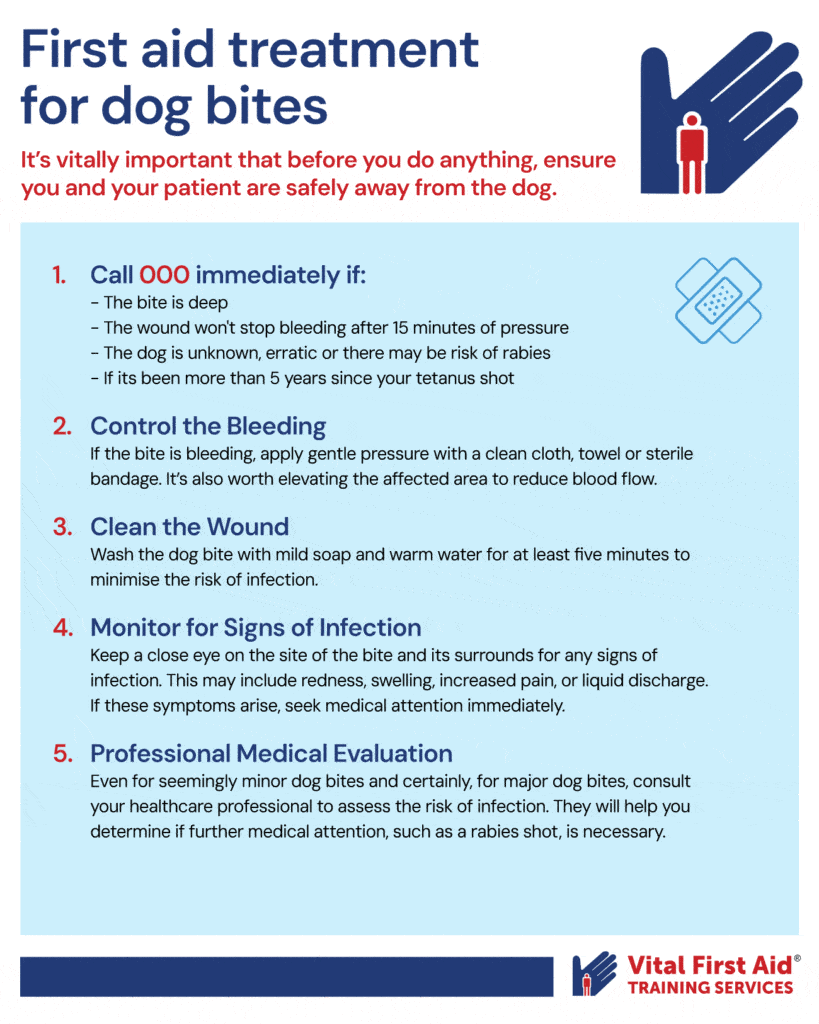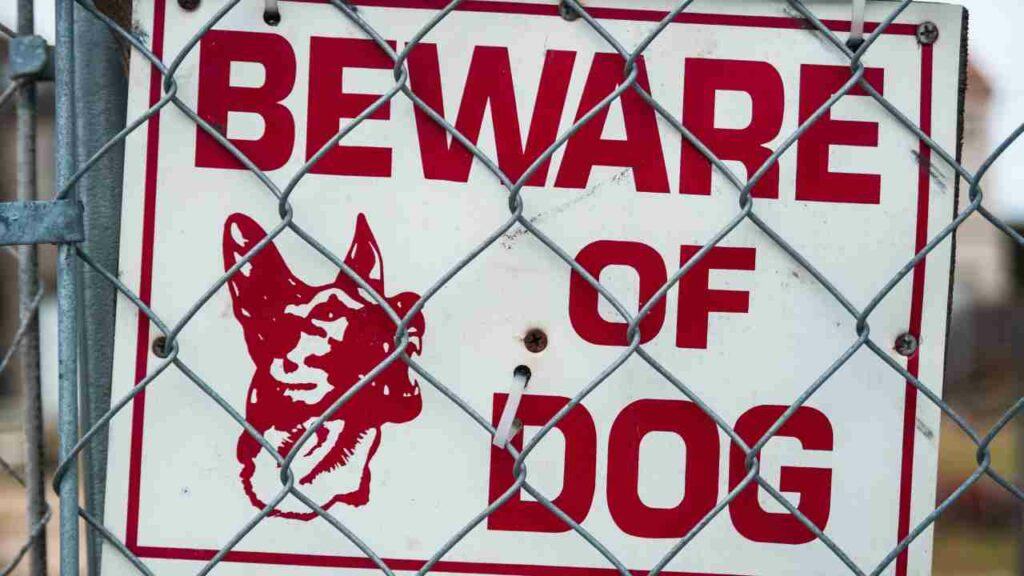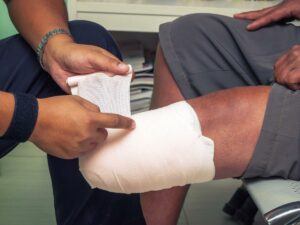The Vital Facts
- Nearly 4,000 people were hospitalised due to a dog-related injury in Australia in 2013–14
- 90% of hospitalisations for people aged under 65 years were due to dog bites
- For adults, the most common body parts injured was the wrist or hand (42%), however for children aged 0–9, injuries to the head were more common (74%)
Source: AIHW
Immediate first aid treatment for dog bites:
- Call 000 immediately if:
– The bite is deep
– The wound won’t stop bleeding after 15 minutes of pressure
– The dog is unknown, erratic or there may be risk of rabies
– If its been more than 5 years since your tetanus shot - Control the Bleeding
- Clean the Wound
- Monitor for Signs of Infection
- Seek Professional Medical Evaluation
See here for more in-depth first aid treatment for dog bites.
Jump to a section in this article:
- How Dangerous Can Dog Bites Be?
- What to Do in a Dog Attack
- When to Call an Ambulance for a Dog Attack
- How to Provide First Aid for Dog Bites
- The Next Step: Complete a First Aid Course!
As much as you may love dogs, it’s crucial to recognise that some pups may not always be as friendly as they seem.
With their wagging tails and playful antics, most dogs are generally adored. However, it’s essential to approach them with caution, especially unknown dogs, as some can be aggressive, and their bites can pose a real danger.
Dog bit incidents are rare compared to the amount of fun-loving and playful interactions you have with them. But despite that, knowing first aid for dog bites is vital and being prepared to respond to a dog attack can ensure your safety and the safety of those around you.
In this blog, we’ll delve into the dangers of dog bites and equip you with the knowledge needed to react fast and effectively and provide first aid for dog bites.
From understanding the basic warning signs of an attack to knowing how to respond to an attack and administering first aid for dog bites, we’ve got you covered.
How Dangerous Can Dog Bites Be?
Dog bites can be much more serious than just being painful. Not only do dogs powerful jaws sometimes cause significant tissue damage, but they also carry a strong risk of infection due to the bacteria in their mouths.
Emotional trauma from a bite can linger as well so it’s vital to take caution in your interactions with these beloved animals.
What to Do in a Dog Attack
In the unfortunate event of a dog attack, staying calm and taking swift, decisive action is paramount to ensure your safety.
If an attack is imminent, you should avoid making sudden movements or direct eye contact, which may further provoke the dog.
A basic rule of thumb is to refrain from screaming or running, as this will often only escalate the situation. Also, running is generally not very effective given the speed of most dogs will be faster than your own. Instead, use a firm, authoritative voice to command the dog to “sit” or “stay”, provided you can do that safely.
If others are present, instruct them to stay still and avoid sudden movements as well.
If the dog attacks and you are knocked to the ground, protect your neck and head with your arms. Then, curl into a ball to minimise the area of your body that the dog can harm.
If and once the dog disengages, slowly and carefully back away without turning your back on it.
Then, seek prompt medical attention, even for seemingly minor injuries, and report the incident to local authorities to prevent future attacks. As a general rule, if the attack has broken your skin, even as a minor cut, you are at risk of an infection.
When to Call an Ambulance for a Dog Attack
There are two main instances where an ambulance should be called.
Mauling
If you or someone else has been mauled – where the injuries are severe or life-threatening – you should call an ambulance. Blood loss and shock can occur quickly so don’t delay.
Children
Small children are unfortunately more likely to be victims of dog attacks, as they are smaller, meaning even small dogs can pose more of a threat. Also, they may not be aware they are irritating a dog until it reacts aggressively.
Try to avoid allowing your child and dog to play unsupervised, and call an ambulance immediately if your child is mauled in a dog attack.
How to Provide First Aid for Dog Bites
During a dog attack, your first priority should be escaping the immediate danger rather than treating any injuries you or someone else has sustained.
So, before attempting any first aid, ensure you or the patient are safely away from the dog, eliminating the threat of further harm. Do not attempt first aid for a dog bite if the dog is still a potential danger.
Then, even if the injuries that were sustained seem minor, administer the following dog bite first aid protocols. This is because all dog bites can carry the risk of infection
1. Clean the Wound
Wash the dog bite with mild soap and warm water for at least five minutes to minimise the risk of infection.
2. Control the Bleeding
If the bite is bleeding, apply gentle pressure with a clean cloth, towel or sterile bandage. It’s also worth elevating the affected area to reduce blood flow.
3. Monitor for Signs of Infection
Keep a close eye on the site of the bite and its surrounds for any signs of infection. This may include redness, swelling, increased pain, or liquid discharge. If these symptoms arise, seek medical attention immediately.
4. Professional Medical Evaluation
Even for seemingly minor dog bites and certainly, for major dog bites, consult your healthcare professional to assess the risk of infection. They will help you determine if further medical attention, such as a rabies shot, is necessary.

The Next Step: Complete a First Aid Course!
You’ll immediately feel more comfortable and confident around our furry friends – especially since dog bites almost always happen unexpectedly.
If you want to ensure the safety of you and your family, you must have the knowledge and skills to confidently administer first aid for dog bites. Furthermore, in the case of a medical emergency, you must be able to respond until professional medical assistance is available.
At Vital First Aid, our qualified first aid trainers are highly skilled and experienced, and all first aid students will receive a First Aid Certificate on completion.
To benefit from our range of first aid courses, sign up here.






